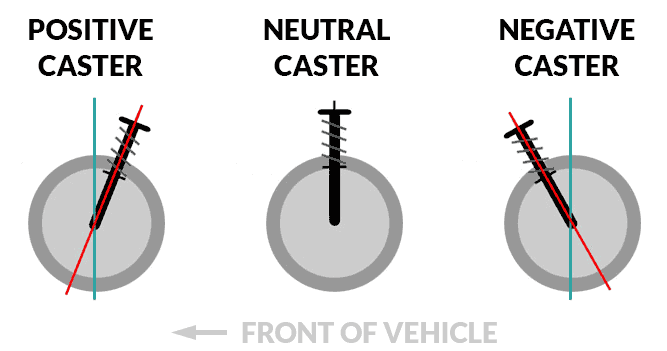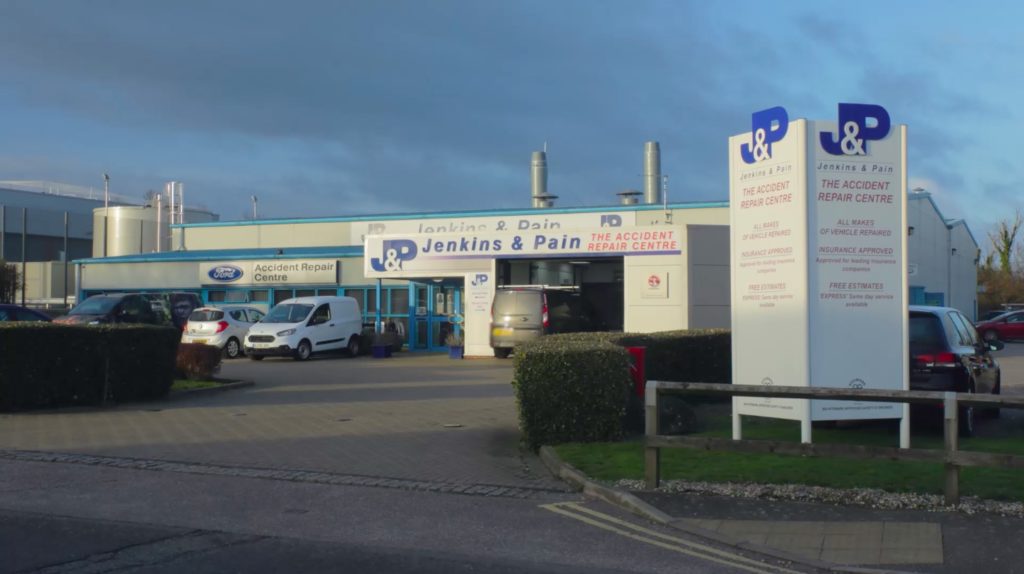Steering geometry is the geometric arrangement of the parts of a steering system, and the value of the lengths and angles within. Steering geometry problems generally tend to occur with wearing and ageing of components. Nevertheless, these problems can also be caused by driving over kerbs, impacting potholes and definitely after the vehicle is involved in a major impact. Also known as wheel alignment, steering geometry is the procedure that is required to check and adjust (if necessary) settings, when they have deviated away from the manufacturers’ specifications. It is also important to remember that if there is cause for re-alignment after a steering geometry inspection, not all geometry values are adjustable. Whenever noticeable deviations from pre-defined settings are observed, the only remedial procedure available could be component replacement. The experts at our body repair centre have explained the essentials about steering geometry, to help you during vehicle repair…
Types of Steering Geometry Adjustments
Camber Angle
The direction the front wheel is leaning relative to the wheel’s vertical centreline is known as the camber angle. Depending on the lean, the camber angle is either positive or negative. When observed from the front of the vehicle if the top of the wheel is leaning towards the engine, it is considered as negative camber. On the other hand, if the top of the wheel is leaning outwards, it is acknowledged as positive camber. Our body repair centre recommends that if during a steering geometry examination, the measurements are outside specified tolerances and the camber angle needs amending, look for evidence of elongated holes on the suspension strut tower, or eccentric washers or bolts securing the upper and lower control arms as a means of adjustment. Without these, scrutiny of the suspension and steering components is essential to check for any potential damage.

Caster Angle
This refers to the positioning of the steering axis centreline from the wheel vertical centreline, when viewed from the side of the vehicle. It is said to be positive castor if the steering axis centreline contacts the road surface ahead of the wheel’s vertical centreline. In contrast, if the steering axis centreline contacts the road surface behind the wheel’s vertical centreline, it implies a negative castor. The majority of modern vehicles are designed with positive castor. In conjunction with the other geometry angles, this choice reduces steering effort and allows the front wheels to self-straighten after a bend has been negotiated.

King Pin Inclination
Also referred to as axle inclination, KPI is achieved differently depending on the suspension arrangement. Typically, KPI is attained by leaning the strut. The angle of the lower and upper swivel joint pivots is offset while with the control arm type suspension.
KPI being non-adjustable can frequently be left overlooked or unchecked during vehicle repair in collision situations. Incorrect KRP caused by damaged or worn suspension components usually results in accelerated tyre wear, along with poor directional stability and increased steering effort (particularly when the vehicle is implementing a parking manoeuvre).
Toe-in and Toe-out
Commonly referred to as tracking, this is the most frequent steering geometry adjustment undertaken. When observed from the front, it is the degree to which the leading edge of the front wheels steer out or in from the vehicle centreline. Wheels that are pointing in towards the vehicle centreline is called toe-in, whereas wheels pointing away are identified as toe-out. Our body repair centre believes that ensuring the vehicle’s toe-in or toe-out measurement is correct offers many advantages. These include better road handling characteristics, improved straight-line stability and more effective steering response. If necessary, this adjustment will also allow minor tweaks to correct suspension bush disparities, caused in production or by accepted wear levels. Our vehicle repair experts encourage you to remember that if adjustment is needed, adjust the track rods equally. However, there is one notable exception to the rule which requires the repositioning of a misaligned steering wheel. This is done by minutely adjusting one track rod more than the other.
In order to prolong the life of tyres and ensure vehicle stability, our body repair centre believes that it is vital to guarantee precise steering geometry alignment. Regular steering geometry checks are advisable, and not only when changing worn tyres, steering or suspension components. Our vehicle repair experts confirm that checks should also be carried out if subframe removal is required to facilitate gearbox or clutch repair work.
Finally, it must be made evident that rear wheel geometry can influence steering stability as well. It is indeed possible to have the front steering geometry angles correctly aligned as well as having a vehicle that pulls to one side or displays abnormal tyre patterns. In these circumstances, it is imperative rear wheel geometry that is also considered when confronted with a vehicle experiencing unusual tyre wear or stability issues.
Use Jenkins & Pain, Award-Winning Accident Repair Centre
There you have it, if you do find yourself with damage to your beloved paintwork and need a car repair or van repair you can count on us to complete all jobs using industry-standard processes. We offer free quotes and with our exclusive repair service, we are sure you will be happy with the results. Contact our Vehicle Body Shop today. Jenkins & Pain are an accident repair centre based in Dover, Kent. We are proud to call ourselves an award-winning accident repair centre. Check out our guide on how to look after your alloys!
Ready to Visit Our Vehicle Body Shop?
We understand how costly and inconvenient it is for a vehicle to be off the road and therefore we use processes that ensure your vehicle is repaired quickly and efficiently. So whether you need minor scratch repairs, major body repair, or alloy wheel refurbishment, our van body shop and car body shop can guarantee a high-quality service. We also repair light commercial vehicles and motorhomes. Contact us today for a paint repair at our Car Body Shop!


